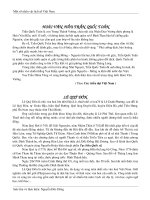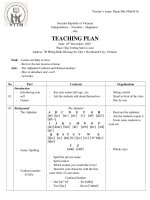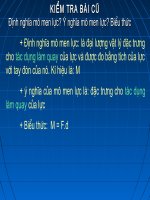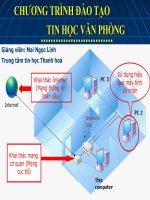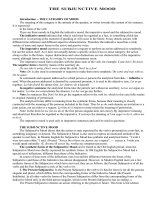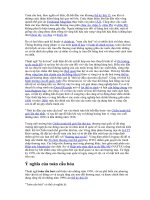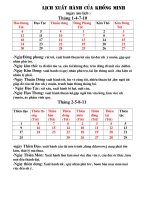tài liệu tham khảo - Modbus basics
Bạn đang xem bản rút gọn của tài liệu. Xem và tải ngay bản đầy đủ của tài liệu tại đây (113.39 KB, 9 trang )
Änderung Datum Vis.:
Typ: Basics Nr.: 1 / 9 gez.: 03.08.06 RR
Bezeichnung:
MODBUS
Zeichnr.: W2417e
Introduction
The Modbus protocol was originally developed by Modicon (nowadays Schneider Electric) for the data transfer with their
controllers. Data transfer was organized in terms of 16-Bit registers (integer format) or as status information in terms of data
bytes. Over the years the protocol was extended and has been adopted by other manufacturers as well. New data types were
added, especially to achieve a higher resolution for values to transmit. The protocol was adopted for new transfer media,
dialects like Modbus Plus or Modbus/TCP arised.
But for compatibility reasons the basic structure of the data area or the addressing mechanism of the protocol retained.
The Modbus protocol is in fact a single master protocol. The master controls the complete transmission and monitors if possible
timeouts (no answer from the addressed device) occur. The connected devices are slaves and are allowed to send telegrams
only on master request.
The following basics are limited to the protocols Modbus/RTU and Modbus/TCP. Also only functions supported by Modbus
devices of the company Camille Bauer are described.
Contents
1. Modbus/RTU protocol 2
1.1 Transmission mode 2
1.2 General message form 2
1.3 Data types 3
1.4 Data addressing 3
1.5 Cyclic redundancy check calculation (crc16) (Example in ‘C)’ 3
1.6 Error handling 4
1.7 Telegram examples 4
2. Modbus/TCP protocol 7
2.1 Generic telegram types 7
2.2 Communication management 7
2.3 Error handling 8
2.4 Telegram examples 8
MODBUS
®
- Modbus is a registered trade mark of Schneider Electric. Detailed protocol specifications are available via the
Website
Änderung Datum Vis.:
Typ: Basics Nr.: 2 / 9 gez.: 03.08.06 RR
Bezeichnung:
MODBUS
Zeichnr.: W2417e
1. Modbus/RTU protocol
1.1 Transmission mode
Character format: Normally configurable
1 start, 8 data, even parity, 1 stop bit
1 start, 8 data, odd parity, 1 stop bit
1 start, 8 data, no parity, 2 stop bit
1 start, 8 data, no parity, 1 stop bit
(often used but not in accordance with MODBUS specification)
Baudrate: Normally configurable, often used values are
1200, 2400, 4800, 9600 and 19200 Bd
1.2 General message form
Device address Function Data CRC check
8 bits 8 bits n * 8 bits 16 bits
The MODBUS
®
specification defines a silent-interval (Pause) of at least 3.5 chars between two telegrams to transmit. Within a
message two chars may be separated for not more than 1.5 chars. A typical data transmission looks like:
Telegram 2
Telegram 1
Telegram 3
Pause
Pause
Pause
etc.
Note: The monitoring of the given interval times is extremely complicated for the master. In particular Windows operating systems are
not suited for such circumstances. Therefore in practice often much longer character intervals are accepted. But this may induce
problems during device addressing, because the message framing can get lost. The receiver of the message may misinterpret
data to be the beginning of a telegram.
Device Address
The device which has to be accessed (Master→Slave communication) or the responding device (Slave→Master
communication). Modbus allows addresses in the range 1 247. The address 0 may be used for broadcast messages to all
devices, if the selected function supports this.
Function
Defines the purpose of data transmission. The following standard function are supported by Camille Bauer devices:
Code MODBUS
-
Function Register Application examples
01
H
READ COIL STATUS 0xxxx - Reading digital output states
02
H
READ INPUT STATUS 1xxxx - Reading digital input states
03
H
READ HOLDING REGISTERS 4xxxx - Reading measurands, meters, mean-values
- Reading the device configuration
08
H
DIAGNOSTIC - Device connection test (subfunction 0)
0F
H
FORCE MULTIPLE COILS 0xxxx - Setting / Simulating digital output states
10
H
PRESET MULTIPLE REGISTERS 4xxxx - Device configuration
Data
Contains the information to transmit. This field is divided into register, number of registers to transmit and, if necessary, read
data or information to store. Data is normally transmitted as a multiple of 16 bit registers.
CRC check
The CRC16 checksum is calculated for all byte of a telegram. It is calculated by the receiver of the message as well to detect
possible transmission errors. The CRC calculation is shown in chapter 1.5
Änderung Datum Vis.:
Typ: Basics Nr.: 3 / 9 gez.: 03.08.06 RR
Bezeichnung:
MODBUS
Zeichnr.: W2417e
1.3 Data types
- Standardized data types are Byte (8-Bit) and Register (16-Bit). According to the Modbus specification registers are
transmitted with the high byte first, followed by the low byte.
- Extended data types: 32-Bit-Integer and 32-Bit-Float are transmitted as 2 consecutive 16-Bit registers. 64-Bit-Integer and
64-Bit-Float are transmitted as 4 consecutive 16-Bit registers. The format of the float numbers is in accordance with IEEE
standard 754. But the transmission sequence of the registers is not fixed. In most applications it works as follows:
32-Bit numbers
Reg_L (Bit 15 0) Reg_H (Bit 31 16)
HByte LByte HByte LByte
64-Bit numbers Reg_L (15 0) Reg_H (31 16) Reg_L (47 32) Reg_H (63 48)
HByte LByte HByte LByte HByte LByte HByte LByte
Transmission sequence 1. 2. 3. 4. 5. 6. 7. 8.
1.4 Data addressing
Modbus groups different data types as references. The telegram functions 03
H
and 10
H
e.g. use register addresses starting at
40001. The reference 4xxxx is implicit, i.e. is given by the used telegram function. In addressing therefore the leading 4 is
omitted. The reference is also not given in most Modbus descriptions.
Another speciality in Modbus telegrams is, that the register numeration starts at 1, but the addressing starts at 0. So if e.g. you
want to read register 40001 the address in the telegram will be 0. This can also be seen in detail in the telegram examples.
1.5 Cyclic redundancy check calculation (crc16) (Example in ‘C)’
The calculation is performed on all message characters, except the check bytes itself. The low-order byte (Crc_LByte) is
appended to the message first, followed by the high-order byte (Crc_HByte). The receiver of the message calculates the check
bytes again and compares them with the received ones.
void main()
{
unsigned char data[NUMDATA+2]; // Message buffer
unsigned char Crc_HByte,LByte; //
unsigned int Crc;
Crc=0xFFFF;
for (i=0; i<NUMDATA; i++) {
Crc = CRC16 (Crc, data[i] );
}
Crc_LByte = (Crc & 0x00FF); // Low byte calculation
Crc_HByte = (Crc & 0xFF00) / 256; // High byte calculation
}
// CRC16 calculation
//
unsigned int CRC16(unsigned int crc, unsigned int data)
{
const unsigned int Poly16=0xA001;
unsigned int LSB, i;
crc = ((crc^data) | 0xFF00) & (crc | 0x00FF);
for (i=0; i<8; i++) {
LSB=(crc & 0x0001);
crc=crc/2;
if (LSB)
crc=crc^Poly16;
}
return(crc);
}
Änderung Datum Vis.:
Typ: Basics Nr.: 4 / 9 gez.: 03.08.06 RR
Bezeichnung:
MODBUS
Zeichnr.: W2417e
1.6 Error handling
If a transmission error occurs, i.e. if the CRC-16 calculated by the recipient doesn't match the received one, no answer
will be sent to the master. This way a timeout will be provoked. The same happens if a non-existing or switched-off
device will be addressed.
If the recipient of a message detects another error, it sends back a corresponding error message to the master.
Device answer:
Address Code Data Check sum
LByte HByte
11
H
Code+80
H
Error code CRC16
The function code received will be sent back. However, the most significant bit (MSB) of the function code will be set. The error
code indicates an operating or a programming error. The following error codes are supported:
Error code Meaning
01
H
The used function code is not supported
02
H
The register address used is not allowed. The register address may be invalid or write-protected.
03
H
Some data values used are out of range, i.e. invalid number of registers.
06
H
Device can not handle the request at the moment. Repeat the request.
1.7 Telegram examples
Function 01
H
: READ COIL STATUS
Example: Request the (digital) output states 2 to 11 of device 17. These are 10 states, which can be mapped within
2 data bytes.
Request
Address Function Data CRC check
Master->Slave Start address Number of states
addr 01
H
High-Byte Low-Byte High-Byte Low-Byte crc16
Answer Address Function Data CRC check
Slave->Master Number of data bytes States 9 2 States 11 10
addr 01
H
8 Bit 8 Bit 8 Bit crc16
Example (Hex): >>>> 11 01 00 01 00 0A crc_l crc_h
<<<< 11 01 02 11 01 crc_l crc_h
11
H
=00010001
B
: Output 6,2 ON; Output 9,8,7,5,4,3 OFF
01
H
=00000001
B
: Output 10 ON; Output 11 OFF
Note: Start address 2 is accessed as register 1 in accordance with the MODBUS specification
Änderung Datum Vis.:
Typ: Basics Nr.: 5 / 9 gez.: 03.08.06 RR
Bezeichnung:
MODBUS
Zeichnr.: W2417e
Function 02
H
: READ INPUT STATUS
Example: Request the (digital) input states 4 to 17 of device 17. These are 14 states, which can be mapped within
2 data bytes.
Request
Address Function Data CRC check
Master->Slave Start address Number of states
addr 02
H
High-Byte Low-Byte High-Byte Low-Byte crc16
Answer Address Function Data CRC check
Slave->Master Number of data bytes States 11 4 States 17 12
addr 02
H
8 Bit 8 Bit 8 Bit crc16
Beispiel (Hex): >>>> 11 02 00 03 00 0D crc_l crc_h
<<<< 11 02 02 2D 3C crc_l crc_h
2D
H
=00101110
B
: Input 9,7,6,5 ON; Input 11,10,8,4 OFF
3C
H
=00111100
B
: Input 17,16,15,14 ON; Input 13,12 OFF
Note: Start address 4 is accessed as register 3 in accordance with the MODBUS specification
Function 03
H
: READ HOLDING REGISTERS
Example: Request a float number(32-Bit) on register addresses 108 and 109 of device 17
Request
Address Function Data CRC check
Master->Slave Start address Number of registers
addr 03
H
High-Byte Low-Byte High-Byte Low-Byte crc16
Answer Address Function Data CRC check
Slave->Master Number of data bytes Information
addr 03
H
n (8 Bit) n/2 registers crc16
Example (Hex): >>>> 11 03 00 6B 00 02 crc_l crc_h
<<<< 11 03 04 CC CD 42 8D crc_l crc_h
Note: Start address 108 is accessed as register 107 in accordance with the MODBUS specification
Function 08
H
: DIAGNOSTICS
Example: Using Subfunction 00 (Diagnostic) a test is performed if device 17 is connected. The telegram sent will
be sent back 1:1.
Request Address Function Data CRC check
Master->Slave Subfunktion Data
addr 08
H
0 0 High-Byte Low-Byte crc16
Answer Address Function Data CRC check
Slave->Master Subfunktion Data
addr 08
H
0 0 High-Byte Low-Byte crc16
Example (Hex): >>>> 11 08 00 00 AA 55 crc_l crc_h
<<<< 11 08 00 00 AA 55 crc_l crc_h
Änderung Datum Vis.:
Typ: Basics Nr.: 6 / 9 gez.: 03.08.06 RR
Bezeichnung:
MODBUS
Zeichnr.: W2417e
Function 0F
H
: FORCE MULTIPLE COILS
Example: Set the (digital) output states 30 46 of device 17. These are 17 states, which fit within 3 data bytes.
Request
Address Function Data CRC check
Master->Slave Start address Number of
states
Number of
bytes
Information
addr 0F
H
High Low High Low n n Bytes crc16
Answer Address Function Data CRC check
Slave->Master Start address Number of states
addr 0F
H
High Low High Low crc16
Beispiel (Hex): >>>> 11 0F 00 1D 00 11 03 AC 38 01 crc_l crc_h
<<<< 11 0F 00 1D 00 11 crc_l crc_h
AC
H
=10101100
B
: Output 37,35,33,32 ON; Output 36,34,31,30 OFF
38
H
=00111000
B
: Output 43,42,41 ON; Output 45,44,40,39,38 OFF
01
H
=00000001
B
: Output 46 ON;
Note: Start address 30 is accessed as register 29 in accordance with the MODBUS specification
Function 10
H
: PRESET MULTIPLE REGISTERS
Supports Broadcast. Via Address 0 an action may be performed for all devices at the same time. This kind of telegrams
is not acknowledged. Typical application: Setting the display brightness of all devices.
Example: Set a long integer number (32-Bit) on register addresses 302 and 303 of device 17.
Request
Address Function Data CRC check
Master->Slave Start address Number of
registers
Number of
bytes
Information
addr 10
H
High Low High Low n n Bytes crc16
Answer Address Function Data CRC check
Slave->Master Start address Number of registers
addr 10
H
High Low High Low crc16
Example (Hex): >>>> 11 10 01 2D 00 02 04 00 0A 01 02 crc_l crc_h
<<<< 11 10 01 2D 00 02 crc_l crc_h
Note: Start address 302 is accessed as register 301 in accordance with the MODBUS specification
Änderung Datum Vis.:
Typ: Basics Nr.: 7 / 9 gez.: 03.08.06 RR
Bezeichnung:
MODBUS
Zeichnr.: W2417e
2. Modbus/TCP protocol
2.1 Generic telegram types
The ADU (Application Data Unit) of the Modbus over TCP/IP protocol is composed of the following parts
MBAP Header Function code Data
7 Bytes 1 Byte n Bytes
MPAP Header (Modbus Application Protocol Header)
Byte 0,1: transaction identifier - Identification number if multiple requests are pending.
Byte 2,3: protocol identifier - always set to 0 (=Modbus protocol)
Byte 4: Number of data bytes following (high byte) - always 0 (because all messages are shorter than 256 bytes)
Byte 5: Number of data bytes following (high byte)
Byte 6: unit identifier (previous ‘device address’). The device is accessed directly via IP address, therefore this parameter
has no function and may be set to 0xFF. Exception: If the communication is performed via gateway the device
address must be set as before.
Function code
Byte 7: Function code of the standard MODBUS protocol. See chapter 1.2
Data
Byte 8 n: The data area corresponds to the standard MODBUS protocol (see chapter 1). The CRC checksum is no longer
necessary because this part is implemented on TCP/IP protocol level.
2.2 Communication management
The Modbus communication requires to establish a TCP connection between a client (e.g. PC) and a server (device). Normally
TCP-Port 502 is used, which is reserved for Modbus communication. However, the user is free to set another port number. A
server normally accepts an additional connection via port 502, besides the configured port.
If a firewall is arranged between server and client you have to ensure that the configured TCP port is released.
It is also possible to use a Modbus RTU/TCP gateway as server to which up to 32 devices can be serially connected. This
allows to connect Modbus/RTU devices directly to the Ethernet without the need to modify the firmware. However, this cost-
effective solution reduces the transmission speed to the baudrate of the serial bus.
Änderung Datum Vis.:
Typ: Basics Nr.: 8 / 9 gez.: 03.08.06 RR
Bezeichnung:
MODBUS
Zeichnr.: W2417e
2.3 Error handling
If a transmission error occurs, i.e. if the CRC-16 calculated by the recipient doesn't match the received one, no answer
will be sent to the master. This way a timeout will be provoked. The same happens if a non-existing or switched-off
device will be addressed. If you use an interconnected Modbus RTU/TCP gateway you will receive an error message if
the accessed device gives no response.
If the recipient of a message detects another error, it sends back a corresponding error message to the master.
Device answer:
MBAP Header Function code Data
Copy of the request Code+80
H
error code
The function code received will be sent back. However, the most significant bit (MSB) of the function code will be set. The error
code indicates an operating or a programming error. The following error codes are supported:
Error code Meaning
01
H
The used function code is not supported
02
H
The register address used is not allowed. The register address may be invalid or write-protected.
03
H
Some data values used are out of range, i.e. invalid number of registers.
06
H
Device can not handle the request at the moment. Repeat the request.
0B
H
Error message of the interconnected gateway: No response of the accessed device.
2.4 Telegram examples
Function 03
H
: READ HOLDING REGISTERS
Request: Read a float number (32-Bit) on register addresses 108 and 109 of device 17
Request
Transact. Protocol Number of unit Function Data
Client->Server identifier identifier Data bytes identifier Start address Number of registers
0x00 tno 0x00 0x00 0x00 0x06 0xFF 03
H
High-Byte Low-Byte High-Byte Low-Byte
Answer Transact. Protocol Number of unit Function Daten
Server->Client identifier identifier Data bytes identifier Number of data bytes Information
0x00 tno 0x00 0x00 0x00 n+3 0xFF 03
H
n n/2 Register
Example (Hex) >>> 00 00 00 00 00 06 FF 03 00 6B 00 02
<<< 00 00 00 00 00 07 FF 03 04 CC CD 42 8D
Note: Start address 108 is accessed as register 107 in accordance with the MODBUS specification. If communication is
performed via gateway the unit identifier must be set to the device address (17).
tno =
Identifikation number if more than request is pending
Änderung Datum Vis.:
Typ: Basics Nr.: 9 / 9 gez.: 03.08.06 RR
Bezeichnung:
MODBUS
Zeichnr.: W2417e
Function 08
H
: DIAGNOSTICS
Example: Using Subfunction 00 (Diagnostic) a test is performed if device 17 is connected. The telegram sent will
be sent back 1:1.
Request Transact. Protocol Number of unit Function Data
Client->Server identifier identifier Data bytes identifier Subfunction Data
0x00 tno 0x00 0x00 0x00 0x06 0xFF 08
H
0x00 0x00 High-Byte Low-Byte
Answer Transact. Protocol Number of unit Function Data
Server->Client identifier identifier Data bytes identifier Subfunction Data
0x00 tno 0x00 0x00 0x00 0x06 0xFF 03
H
n High-Byte Low-Byte
Example (Hex) >>> 00 00 00 00 00 06 FF 08 00 00 AA 55
<<< 00 00 00 00 00 06 FF 08 00 00 AA 55
Note: If communication is performed via gateway the unit identifier must be set to the device address (17).
Function 10
H
: PRESET MULTIPLE REGISTERS
Example: Set a long integer number (32-Bit) on register addresses 400 and 401 of device 17.
Request
Transact. Protocol Number of unit Function Data
Client->Server identifier identifier Data bytes identifier Start addr. #Reg. #Bytes Info
0x00 tno 0x00 0x00 0x00 n+7 0xFF 10
H
High Low High Low n n Bytes
Answer Transact. Protocol Number of unit Function Data
Server->Client identifier identifier Data bytes identifier Start address Numb. registers
0x00 tno 0x00 0x00 0x00 0x06 0xFF 10
H
High-Byte Low-Byte High-Byte Low-Byte
Example (Hex) >>> 00 00 00 00 00 0B FF 10 01 8F 00 02 04 d2 d1 d4 d3
<<< 00 00 00 00 00 06 FF 10 01 8F 00 02
Note: Start address 400 is accessed as register 399 in accordance with the MODBUS specification. If communication is
performed via gateway the unit identifier must be set to the device address (17).
tno =
Identifikation number if more than request is pending

